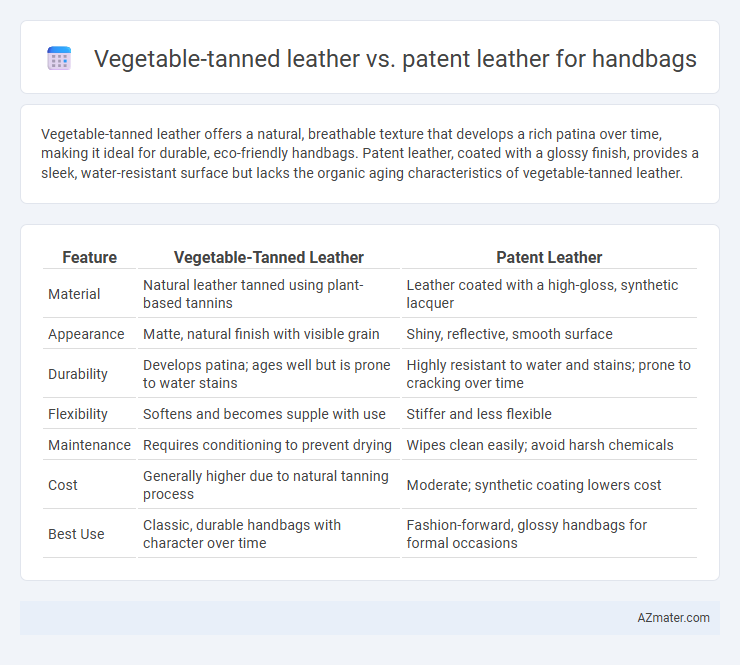Vegetable-tanned leather offers a natural, breathable texture that develops a rich patina over time, making it ideal for durable, eco-friendly handbags. Patent leather, coated with a glossy finish, provides a sleek, water-resistant surface but lacks the organic aging characteristics of vegetable-tanned leather.
Table of Comparison
| Feature | Vegetable-Tanned Leather | Patent Leather |
|---|---|---|
| Material | Natural leather tanned using plant-based tannins | Leather coated with a high-gloss, synthetic lacquer |
| Appearance | Matte, natural finish with visible grain | Shiny, reflective, smooth surface |
| Durability | Develops patina; ages well but is prone to water stains | Highly resistant to water and stains; prone to cracking over time |
| Flexibility | Softens and becomes supple with use | Stiffer and less flexible |
| Maintenance | Requires conditioning to prevent drying | Wipes clean easily; avoid harsh chemicals |
| Cost | Generally higher due to natural tanning process | Moderate; synthetic coating lowers cost |
| Best Use | Classic, durable handbags with character over time | Fashion-forward, glossy handbags for formal occasions |
Introduction to Handbag Leather Types
Vegetable-tanned leather offers a natural, durable, and eco-friendly option for handbags, known for its rich patina development over time. Patent leather features a glossy, high-shine finish created through a coating process, making it highly resistant to water and stains. These distinct tanning methods influence the handbag's appearance, texture, and maintenance requirements, catering to different style preferences and usage conditions.
What is Vegetable-Tanned Leather?
Vegetable-tanned leather is a natural, eco-friendly material tanned using tannins extracted from tree bark, leaves, and other plant sources, offering durability and a unique patina that improves with age. This type of leather is breathable and develops character over time, making it ideal for luxury handbags that age gracefully and have a distinctive, natural finish. In contrast, patent leather is coated with a glossy, synthetic finish providing a shiny, smooth surface but sacrificing breathability and natural aging qualities.
What is Patent Leather?
Patent leather is a type of leather that features a high-gloss, shiny finish achieved through a coating of lacquer or varnish, making it durable and water-resistant. Unlike vegetable-tanned leather, which develops a natural patina over time, patent leather maintains its polished appearance with minimal maintenance. This distinct glossy surface makes patent leather a popular choice for handbags that prioritize aesthetic appeal and ease of cleaning.
Durability Comparison: Vegetable-Tanned vs Patent Leather
Vegetable-tanned leather offers superior durability due to its natural tanning process, which enhances toughness and develops a unique patina over time, making it ideal for long-lasting handbags. Patent leather, while visually striking with its glossy finish, is more prone to cracking and scuffing under frequent use, limiting its longevity compared to vegetable-tanned leather. The inherent strength and flexibility of vegetable-tanned leather ensure better resistance to wear, making it a more practical choice for handbags requiring durability.
Appearance and Style Differences
Vegetable-tanned leather showcases a natural, matte finish with rich, earthy tones that develop a unique patina over time, offering a timeless, rustic appeal ideal for classic and artisanal handbags. Patent leather features a high-gloss, reflective surface with a smooth texture, delivering a bold, polished look suited for modern, fashion-forward designs. The contrasting finishes highlight the natural aging of vegetable-tanned leather versus the sleek, consistent shine of patent leather, influencing the handbag's overall aesthetic and perceived luxury.
Environmental Impact and Sustainability
Vegetable-tanned leather is prized for its eco-friendly process, using natural tannins from tree bark and plants that reduce chemical waste and biodegrade more readily compared to patent leather. Patent leather undergoes heavy chemical treatments and coating with synthetic polymers, which hinder its recyclability and increase environmental pollution. Choosing vegetable-tanned leather promotes sustainability by minimizing toxic byproducts and supporting a more natural, renewable resource cycle for handbag manufacturing.
Maintenance and Care Requirements
Vegetable-tanned leather requires regular conditioning with natural oils or creams to prevent drying and cracking, as it is more porous and sensitive to moisture and stains. Patent leather, coated with a glossy finish, demands gentle cleaning with a damp cloth to preserve its shine and avoid scratches, but it is generally more resistant to water and stains. Both types benefit from storage in a cool, dry place away from direct sunlight to maintain their appearance and longevity.
Price and Value Considerations
Vegetable-tanned leather handbags typically command higher prices due to their natural, eco-friendly tanning process and unique aging characteristics, offering long-term value through durability and a developing patina. Patent leather handbags, often more affordable, provide a glossy, polished finish that is less breathable and may be prone to cracking over time, potentially diminishing resale value. When considering price and value, vegetable-tanned leather stands out for its longevity and investment appeal, while patent leather suits buyers seeking immediate aesthetic impact at a lower cost.
Best Uses: When to Choose Each Type
Vegetable-tanned leather is ideal for handbags requiring durability, natural aging, and a unique patina, making it perfect for everyday use and classic styles. Patent leather offers a glossy, polished finish suited for formal occasions and evening bags where a sleek, high-shine appearance is desired. Choose vegetable-tanned leather for a rugged, long-lasting look and patent leather for a statement, fashion-forward handbag that stands out.
Final Verdict: Which Leather is Better for Handbags?
Vegetable-tanned leather offers superior breathability, natural aging, and eco-friendly qualities ideal for handbags seeking durability and a rustic aesthetic. Patent leather provides a glossy, water-resistant finish that is easier to clean and perfect for formal or fashion-forward styles. Choosing between them depends on whether longevity and natural character (vegetable-tanned) or a sleek, shiny appearance with low maintenance (patent) is the priority.

Infographic: Vegetable-tanned leather vs Patent leather for Handbag
 azmater.com
azmater.com